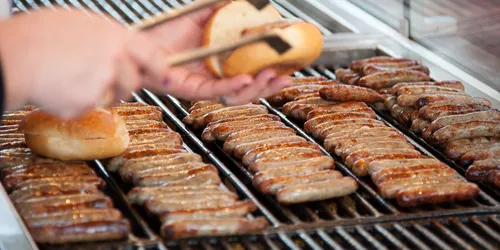Bavarian specialities
Be warned – these trip tips may not be to vegetarians' tastes. Because it's all about sausages here – whether they're fried, smoked or boiled, there's something for everyone. A culinary journey from north to south.

Be warned – these trip tips may not be to vegetarians' tastes. Because it's all about sausages here – whether they're fried, smoked or boiled, there's something for everyone. A culinary journey through the region, hunting for Bavarian specialities from north to south.
One of the most famous Bavarian specialities is definitely the Weißwurst (traditional white Bavarian sausage). It is usually on the breakfast menu in cafés and restaurants, as it is traditionally eaten before midday. This is because there previously was no reliable way of cooling things and the sausage meat was very delicate; this meant that you could only keep them for a couple of hours. Even though things have obviously changed a lot since then, the Munich creation is still normally eaten before midday even now.
If you hear someone whistling behind you in Hof, it might be the "Wärtschlamo" (traditional sausage seller). The traditional call of the sausage seller is a loud whistle followed by "Haaß senn sa – kolt wern sa" ("Get them hot – they'll soon be cold"). Anyone who fancies getting themselves a wiener, Knackwurst (a type of sausage widespread throughout Germany), Weißwurst or Bauernwurst (a spicy German sausage), simply has to follow their nose – sausage sellers work in the old town of Hof from Monday to Friday, as well as on Saturday morning.
The Würzburger Feuerwurst (Würzburg fiery sausage) has become a cult favourite. Many people who encounter the 50-centimetre-long Bavarian speciality for the first time reach for their camera straight away. But the hot and spicy sausage isn't just a treat for the eye, but also for your tastebuds. The inventors at the Treziak snack stall won't reveal their secret recipe though.
The Franconian speciality "Drei im Weggla" (three sausages in a bun) is available at many stands in pedestrian areas and in restaurants like the "Bratwursthäusle" (little roast sausage house) in Nuremberg. After eating, you can walk from there back to the main station. On the approximately one-kilometre-long route through the old town, you can get a good idea of what Nuremberg is like. This is because the main market, the Fleischbrücke bridge and the Pegnitz river count among the landmarks of the Franconian city.
How did the Upper Franconian sausage specialist "Bauernseufzer" (which means farmer's sigh) get its name? There are lots of stories about this. One of them goes like this – about one hundred years ago, roast sausages were a special treat reserved for feasts in the countryside. Good meat was immediately made into sausages, smoked and put in the pantry for storage after slaughter. If people came to visit, the host had to serve the sausages – but only reluctantly and with a heavy sigh.
The Milzwurst (spleen sausage) is most common in Lower Bavaria. It shares its main ingredient with the most Bavarian of all Bavarian specialities – it is 65 per cent Munich Weißwurst sausage meat. But the two sausages are prepared in completely different ways. While the Weißwurst is boiled, the Milzwurst is usually either browned in the pan, coated with breadcrumbs and fried or roasted in the oven.
To ensure that the skin of the Rote Wurst (traditional red-coloured sausage) doesn't burst on the grill, it is slit a number of times with a sharp knife. It is particularly common for a cross to be cut into the ends of the sausage. But every cook has their own scoring technique for perfect results. Grilled so it is nice and crispy, the Rote Wurst is traditionally placed in a bun and eaten with mustard.